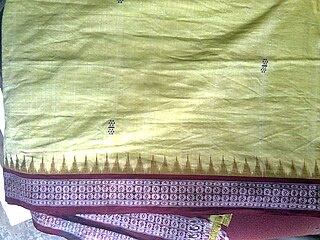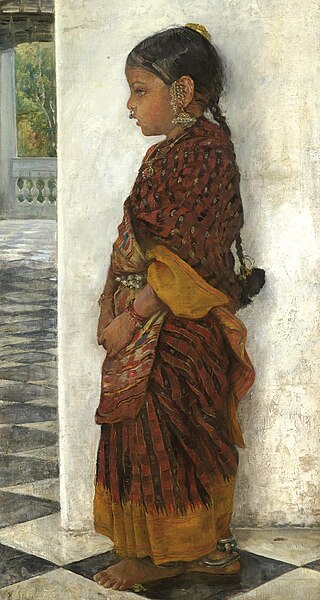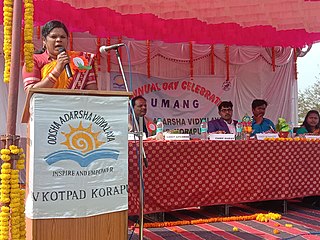Gobardhan Panika | |
|---|---|
| Born | |
| Occupation | Weaver |
| Spouse | Jemamani Panika |
| Awards | Padma Shri Sant Kabir Award National Award |
Gobardhan Panika is an Indian master weaver of Kotpad handloom a traditional tribal craft. [1] The Government of India awarded him the fourth highest civilian honour of the Padma Shri, in 2018, for his contributions to the art of weaving. [2]
Gobardhan Panika was born in a small village called Kotpad, Koraput district, Odisha, India. He was 12-year-old when he left school and took up the family business of weaving. He married Jema Panika who won a National Award in 2009 [3] for ethnic handloom products. [4] [5]
His hand-woven textiles have tribal motifs that are geometrical, also drawn from nature - tortoises, crabs, birds flowers, animals, fish, pyramids. [6] Panika weaves saree, shawl, towel and other products which are 100% cotton with natural thread fibers.
Process of weaving starts with a hand spun cotton yarn from the Handloom Society which is then treated with a month-long dyeing process even before being made a fabric. The dyes are extracts of the Aaljhaad(Indian Madder) tree barks. Only two primary shades are used - textured red and coffee brown. The process involves soaking the yarn in oil, mixing with cow dung for disinfecting, washing in a running stream, boiling it 40 times for seasoning and roughening for a coarse feel. The barks are separately taken out in flakes for powdering in a refined process that gets mixed and boiled with the yarn. It would take a week to weave a dupatta, and a month for a saree. [7]
The red colour comes from the roots of the aal tree (Indian Madder). Shades of red, maroon and dark brown can be obtained depending on the ageing of the madder and the way the dye is processed (under the sun, in clay pots). Black is developed by adding powdered kumhar-pathar (sulphate of iron; they buy it from blacksmiths). [8]
Gobardhan Panika has been featured in English Documentary Kotpad Weaving : The Story of a Race Against Time, directed by Biswanath Rath. This documentary explores the uniqueness of Kotpad Handloom, the issues and possible solutions for revival of Kotpad Weaving and Dyeing. [14]
The documentary was telecasted on DD National on 24 March 2018. [15]

Jamdani is a fine muslin textile produced for centuries in South Rupshi of Narayanganj district in Bangladesh on the bank of Shitalakhwa river.

Khadi, derived from khaddar, is a hand-spun and woven natural fibre cloth promoted by Mahatma Gandhi as swadeshi (self-sufficiency) for the freedom struggle of the Indian subcontinent, and the term is used throughout India, Pakistan and Bangladesh. The first piece of the hand-woven cloth was manufactured in the Sabarmati Ashram during 1917–18. The coarseness of the cloth led Gandhi to call it khadi. The cloth is made from cotton, but it may also include silk or wool, which are all spun into yarn on a charkha. It is a versatile fabric that remains cool in summer and warm in winter. To improve its appearance, khadi is sometimes starched to give it a stiffer feel. It is widely accepted in various fashion circles.
Kotpad is a town and a notified area committee in Koraput district in the Indian state of Odisha. Nearest railway station to Kotpad is Kotpad Road station which is a part of East Coast railway.

A Sambalpuri sari is a traditional handwoven bandha (ikat) sari wherein the warp and the weft are tie-dyed before weaving. It is produced in the Sambalpur, Balangir, Bargarh, Boudh and Sonepur districts of Odisha, India. The sari is a traditional female garment in the Indian subcontinent consisting of a strip of unstitched cloth ranging from four to nine meters in length that is draped over the body in various styles.

Bomkai sari or Bomkai Saree is a handloom saree from Odisha, India. It is an origin of Bomkai village from Ganjam district, however later it is mainly produced by the Bhulia community of Subarnapur district. Bomkai is one of the identified Geographical Indications of India. Bomkai Sarees are popular items displayed at various fashion shows.

Pochampally sari or Pochampalli ikat is a saree made in Bhoodan Pochampally, Yadadri Bhuvanagiri district, Telangana State, India. They have traditional geometric patterns in "Paagadu Bandhu" (Ikat) style of dyeing. The intricate geometric designs find their way into sarees and dress materials. The Indian government's official airplane company, Air India, has its cabin crew wear specially designed Pochampally silk sarees.

Gajam Anjaiah, an Indian master handloom designer, who is widely recognised in the handloom industry for his innovations and developments of Tie and Dye handloom products along with Telia Rumal technique of weaving based on Ikat tie-dye process. He received Padma Shri from Government of India under Art category in 2013. He is known for his excellence in traditional handloom design works, such as Puttapaka Sarees in Tie and dye skill, that is the traditional art of designing on paper and then transferring it on to cloth. His dedication to the Handloom Industry has kept the Indian tradition of weaving alive, brought livelihood to the weavers and gave exclusive/unique designed handloom products to the people in India.
Puttapaka Saree is a saree made in Puttapaka village, Samsthan Narayanpuram mandal in Nalgonda district, India. It is known for its unique Puttapaka tie and dye style of sarees.

Kailash Chandra Meher is an Indian artist, inventor, and social activist. He is a painter of contemporary modern art paintings and traditional Tussar Pattachitra paintings of Odisha. He was a recipient of the Padma Shri by the Government of India in 2013.

Handloom saris are a traditional textile art of Bangladesh and India. The production of handloom saris is important for economic development in rural India.
Kunja Bihari Meher was an Indian master craftsman and weaver from Odisha. Born in the Bargarh district, he is known for the Ikkat tradition of weaving, found in the Sambalpuri sarees of Odisha, and is credited with the development of Sambalpuri handloom industry. He was awarded the fourth highest civilian award of the Padma Shri by the Government of India, in 1998. He posthumously won the National Award for Handicrafts of the National Centre for Textile Design in 2009. His son, Surendra Meher, is also a known weaver. Meher died in Barapali on 30 June 2008.
Chaturbhuj Meher is an Indian weaver, considered one of the master weavers of the Tie-dye handloom tradition of Odisha. Born on 13 October 1935 at Sonepur in Odisha, he had formal education only up to school level but learned the traditional weaving craft to join Weavers' Service Centre as a Weaver. Vayan Vihar, a handloom factory and Handloom Research and Training Center, a research institute in Sonepur have been founded by him and he is known to have trained over 10,000 craftsmen.
Mangalagiri sarees and fabrics are produced by performing handicraft weaving in Mangalagiri, a town in Guntur district of the Indian state of Andhra Pradesh. It was registered as one of the handicrafts in the geographical indication from Andhra Pradesh by Geographical Indications of Goods Act, 1999.

Habaspuri is a cotton-based traditional handloom textiles of Odisha, India. Habaspuri sari is a major product of this textile. The Bhulia weavers of Chicheguda, Kalahandi district, Odisha are originally attributed for weaving of the Habaspuri fabric. For its uniqueness in weaving, design and production, it has been identified as one of the 14 Geographical Indications of Odisha.
Kotpad Handloom is a vegetable-dyed fabric woven by the tribal weavers of the Mirgan community of Kotpad village in Koraput district, Odisha, India. Cotton sarees with solid border and Pata Anchal, duppatta with typical Buties / motifs, Scolrfs on cotton, silk, handloom stoles, and dress materials are all dyed with organic dyes. The natural dye is manufactured from the aul tree grown in this area. The Kotpad tussar silk saree with tribal art and Kotpad handloom fabrics with natural color is its specialty.

Biswanath Rath is an Indian film director, screenwriter, editor and producer. His films have received a total of 530 recognition/awards in various International Film Festivals across the globe. He is the Odia filmmaker to achieve the milestone of winning 500 film festival accolades which includes 118 awards. He is the founder of production company BnR Films LLP.

Padmini Dian is an Indian politician. She was elected to the Odisha Vidhan Sabha from Kotpad constituency, Odisha, in the 2019 Indian general election as a member of the Biju Janata Dal. She is currently serving in the Odisha Legislative Assembly as Minister for Textiles, Handlooms & Handicrafts.
Biren Kumar Basak is an Indian handloom weaver from the Nadia district. He is the recipient of Padma Shri, the fourth highest civilian award of India.

Shantipuri sari is a traditional handwoven cotton sari of West Bengal. It is produced in the Shantipur city and surrounding area of Nadia district, West Bengal. Shantipuri handloom sari is famous for the novelty of designs, hand spinning method with extra weft, different color patterns and the thin finesse of the fabric. The fine Shantipuri sari is a highly demanded commodity all over the world. Shantipuri Sari got geographical indications tag in 2009.
Lipsa Hembram is an Indian fashion designer. She works on traditional women's Santal's costumes. She started her business in 2014. She is the founder of her Brand Galang Gabaan. Galang Gabaan is a Santali word which literally mean weave and create. Her simple designs bring Santali traditions into the modern fashion industry. Her products are not only retailed across the country, but also used in the Hindi film industry. Her fashion company has brought socio-economic changes to the tribal communities of India. For this she is considered one of the most influential Women from an indigenous community in her home country.
{{cite news}}: CS1 maint: unfit URL (link)